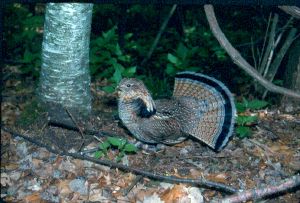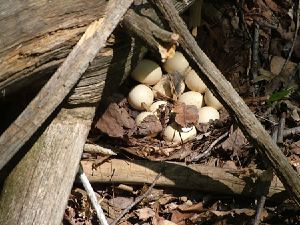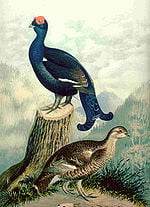Grouse
| Grouse | ||||||||||
|---|---|---|---|---|---|---|---|---|---|---|
| Greater Sage-Grouse, Centrocercus urophasianus Greater Sage-Grouse, Centrocercus urophasianus
| ||||||||||
| Scientific classification | ||||||||||
| ||||||||||
|
Grouse (plural: grouse or grouses) is the common term for any members of the about 20 species of plump, chickenlike, terrestrial birds comprising the family Tetraonidae of the order Galliformes. Grouse inhabit temperate and subarctic regions of the northern hemisphere. They are game and are sometimes hunted for food. The common names of prairie-chickens, ptarmigans, and capercaillies also are used for some species of grouse.
Description
Grouse tend to be plump birds that have a protective coloration of mottled brown, gray, and red feathers, which cover the nostils and partially or entirely cover the legs, with feathers to the toes.
Most species of grouse are year-round residents, and do not migrate. Lagopus lagopus (ptarmigan or snow grouse) lives in artic regions of the northern hemisphere, but migrates to the northwestern United States in the winter. These birds feed mainly on vegetables, but will also feed on insects, especially when feeding young.
In all but one species (the willow grouse), males are polygamous, and many species have elaborate courtship displays. The ruffed grouse (Bonasa umbellus) is known for drumming on a fallen log to attract females. Two species (Tympanuchus cupido or prairie-chicken, and Centrocercus urophasianus or sage grouse) are known for inflating neck air sacs to great size as part of the courtship ritual.
The American Ornithologists' Union includes grouse (Tetraonidae) as a subfamily of Phasianidae. Seven genera are commonly recognized: Falcipennis, Dendragapus, Lagopus, Tetrao, Bonasa, Tympanuchus, and Centrocercus. Based on mtDNA sequences, some systematists believe that certain species belong in new genera (Gutierrez et al. 2000).
Two of the most common species, the ruffed grouse (Bonasa umbellus), the most common species in the eastern United States, and the black grouse (Lyrurus tetrix), the best-known European species, are described below.
Species
Genus Falcipennis
- Siberian Grouse, Falcipennis falcipennis
- Spruce Grouse, Falcipennis canadensis
Genus Dendragapus (Blue Grouse; now split into two species)
- Dusky Grouse, Dendragapus obscurus
- Sooty Grouse, Dendragapus fuliginosus
Genus Lagopus
- Willow Grouse (Willow Ptarmigan in North America), Lagopus lagopus
- Red Grouse L. l. scoticus - Possibly a distinct species.
- Ptarmigan (Rock Ptarmigan in North America), Lagopus mutus
- White-tailed Ptarmigan, Lagopus leucurus
Genus Tetrao
- Eurasian Black Grouse, Tetrao tetrix
- Caucasian Black Grouse, Tetrao mlokosiewiczi
- Capercaillie, Tetrao urogallus
- Black-billed Capercaillie, Tetrao parvirostris
Genus Bonasa
- Hazel Grouse, Bonasa bonasia
- Severtzov's Grouse, Bonasa sewerzowi
- Ruffed Grouse, Bonasa umbellus
Genus Centrocercus
- Greater Sage-Grouse, Centrocercus urophasianus
- Gunnison Sage-Grouse, Centrocercus minimus
Genus Tympanuchus
- Sharp-tailed Grouse, Tympanuchus phasianellus
- Greater Prairie-Chicken, Tympanuchus cupido
- Heath Hen, T. c. cupido (extinct, 1932) - possibly a distinct species
- Lesser Prairie-Chicken Tympanuchus pallidicinctus
Ruffed grouse
http://en.wikipedia.org/wiki/Image:RuffedGrouse23.jpg The Ruffed Grouse, Bonasa umbellus, is a medium-sized grouse occurring in forests across Canada and the appalachian and northern United States including Alaska. They are non-migratory.
The Ruffed Grouse is frequently called the “partridge.” This leads to confusion with the Gray, or Hungarian, Partridge, which was introduced to Canada from Europe. The Ruffed Grouse is only distantly related to the Gray Partridge, which is a bird of open areas, not woodlands.
Ruffed Grouse have two distinct color phases, grey and red. In the grey phase, adults have a long square brownish tail with barring and a black subterminal band near the end. The head, neck and back are grey-brown; they have a light breast with barring. The ruffs are located on the sides of the neck. These birds also have a "crest" on top of their head, which sometimes lays flat. Both sexes are similarly marked and sized, making them difficult to tell apart, even in hand. The female often has a broken subterminal tail band, while males often have unbroken tail bands. Another fairly accurate method for sexing ruffed grouse involves inspection of the rump feathers. Feathers with a single white dot indicate a female, feathers with more than one white dot to indicate that the bird is a male.
Ruffed Grouse have never been successfully bred in captivity.
These birds forage on the ground or in trees. They are omnivores, eating buds, leaves, berries, seeds, and insects. According to Don L. Johnson, "More than any other characteristic, it is the ruffed grouse's ability to thrive on a wide range of foods that has allowed it to adapt to such a wide and varied range of habitat on this continent. A complete menu of grouse fare might itself fill a book...One grouse crop yielded a live salamander in a salad of watercress. Another contained a small snake." [1]
The male is often heard drumming on a fallen log in spring to attract females for mating. Females nest on the ground, typically laying 6-8 eggs. Grouse spend most of their time on the ground, and when surprised, may explode into flight, beating their wings very loudly.
The Ruffed Grouse is the state bird of Pennsylvania.
Ruffed Grouse are hunted across their entire range, and are very enjoyable to hunt. Population densities across the continent have declined severely in recent decades, primarily due to habitat loss. Many states in the U.S. have open Grouse hunting seasons that run from October through January, but hunting is not considered to be a significant contributing factor in the population decline.
Ruffed Grouse are pursued by hunters both with and without the aid of dogs, and in most states are taken legally only with shotguns or through falconry.
Black grouse
http://en.wikipedia.org/wiki/Image:Black_Grouse.jpg The Black Grouse or Blackgame (Tetrao tetrix) is a large bird in the grouse family. It is a sedentary species, breeding across northern Eurasia in moorland and bog areas near to woodland, mostly boreal. The Black Grouse is closely related to the Caucasian Black Grouse. These birds have a group display or lek in early spring.
As with many Gamebirds, the male is larger than the female at 49-55 cm compared to her 40-45 cm length. The cock is very distinctive, with black plumage, apart from red wattles and a white wingbar, and a lyre-shaped tail, which appears forked in flight. His song is loud, bubbling and somewhat dove-like.
The female is greyish-brown and has a cackling call. She takes all responsibility for nesting and caring for the chicks, as is typical with gamebirds.
The male and female are sometimes referred to by their folk names, Blackcock and Greyhen respectively.
Black grouse have a very distinctive and well recorded courtship ritual or game. At dawn in the spring, the males strut around in a traditional area and display whilst making a highly distinctive mating call. This process is called a Lek - the grouse are said to be leking.
Black Grouse can be found across Europe from Great Britain (but not Ireland) through Scandanavia and into Russia. In eastern Europe they can be found in Poland, Latvia, Estonia, Lithuania and Poland. There is a population in The Alps, and isolated remnants in Germany, Denmark, France and Holland.
This species is declining in western Europe due to loss of habitat, disturbance, predation by foxes, crows etc and small populations gradually dying out.
They have declined in the UK (especially England), having disappeared from many of their former haunts. They are now extinct in Staffordshire, Lancashire, Derbyshire, Exmoor, East Yorkshire, New Forest, Nottinghamshire, Worcestershire, Quantock Hills, Cornwall, Dartmoor, Kent, Wiltshire and Surrey.
A programme to re-introduce Black Grouse into the wild started in 2003 in the Upper Derwent Valley area of the Peak District in England. 30 grouse were released in October 2003, followed by 10 male grouse in December 2004 and a further 10 male and 10 female in April 2005. The programme is being run jointly by the National Trust, Severn Trent Water and Peak District National Park.
Conservation groups helping to revive the Black Grouse include the RSPB and the Game Conservancy Trust.
ReferencesISBN links support NWE through referral fees
- BirdLife International 2004. [1]. 2006 IUCN Red List of Threatened Species., World Conservation Union. Retrieved on 11 May 2006. Database entry includes justification for why this species is of least concern
References
- ↑ Grouse & Woodcock: A Gunner's Guide, by Don L. Johnson (Krause Publications, 1995. ISBN: 0-87341-346-6), p. 37.
Gutiérrez, R.J., Barrowclough, G.F. & Groth, J.G. 2000: A classification of the grouse (Aves: Tetraoninae) based on mitochondrial DNA sequences. - Wildl. Biol. 6: 205-211 [2].
Additional Reading
- BirdLife International 2004. [3]. 2006 IUCN Red List of Threatened Species., World Conservation Union. Retrieved on 11 May 2006. Database entry includes justification for why this species is of least concern
External links
- Grouse videos on the Internet Bird Collection
Credits
New World Encyclopedia writers and editors rewrote and completed the Wikipedia article in accordance with New World Encyclopedia standards. This article abides by terms of the Creative Commons CC-by-sa 3.0 License (CC-by-sa), which may be used and disseminated with proper attribution. Credit is due under the terms of this license that can reference both the New World Encyclopedia contributors and the selfless volunteer contributors of the Wikimedia Foundation. To cite this article click here for a list of acceptable citing formats.The history of earlier contributions by wikipedians is accessible to researchers here:
The history of this article since it was imported to New World Encyclopedia:
Note: Some restrictions may apply to use of individual images which are separately licensed.



